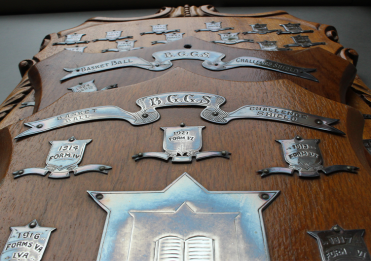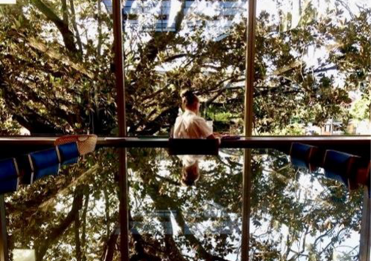The Head Girls honour board resides in the ‘seat of power’: the Annie Mackay Room in the iconic Main Building. This space is also considered by many Grammar Women as the heart of the School, both geographically and emotionally. There are many special boards housed there but what stories does this particular one tell us? What is its significance? How important is it to past, present, and future Grammar girls?
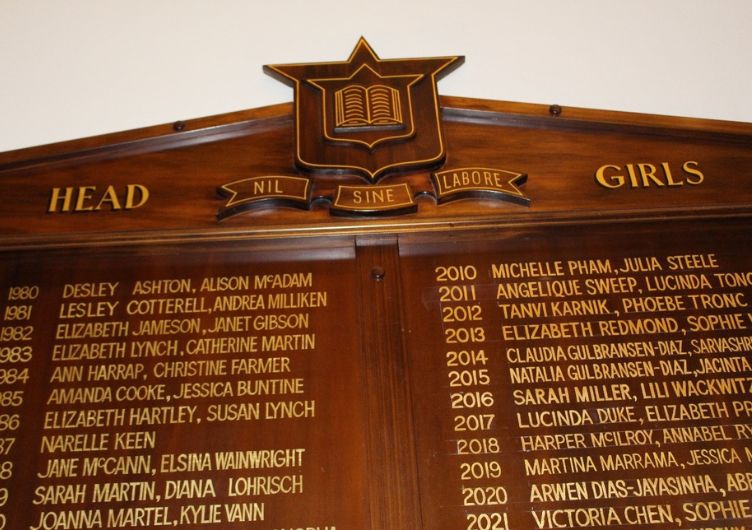
2023 Head Girls Honour Board (detail)
The board sits on the western wall of the room and is surrounded by other significant panels, including the Mary Mackinlay board, unveiled in 1904, the OGA Defence Forces Honour Board, donated in 1949, the Lady Lilley Gold Medal Board, the Chairs of Trustees, and the Principals. These boards represent the commitment and service so many have given to the School.
When the Main Building was refurbished in 1990, it was decided to incorporate a number of new commemorative pieces to accompany the Mary Mackinlay and OGA Defence Forces Honour Boards. The design of these boards was a copy of the relatively new Sports Honour Board unveiled in the gymnasium in 1983. Designed by graphic artist, Mr Lindsay Colwill, in consultation with the School’s carpenters, Robert Vogler and Charles Greig, these elegant, stained, and polished wooden boards were built on the premises. The signwriting, staining, and polishing were delegated to Wally Lewis (not of Rugby League fame) who had had the responsibility of updating each board across many years.
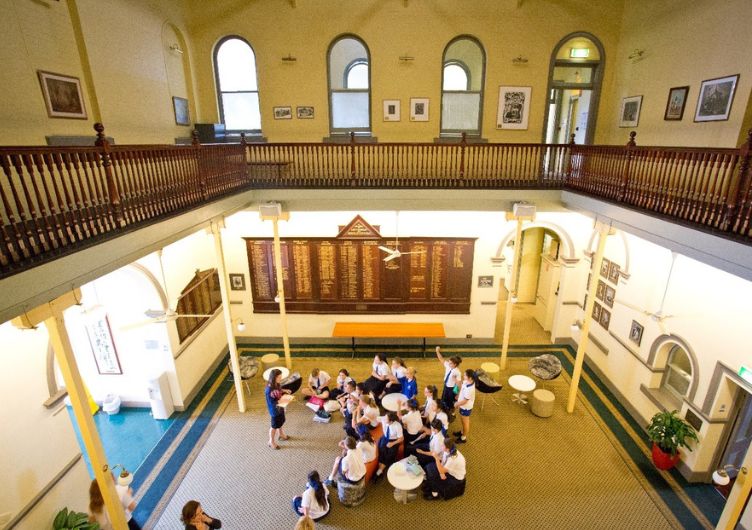
2015 Annie Mackay Room
The Head Girls Honour Board starts the listing of students from 1920. This is a mystery in itself, as the School had prefects well before this and we have evidence of Head Girls as early as 1896. Annual Reports, recollections, and magazine articles tell us that, in 1896, Dora Franz was ‘Head of the School’. The 1897 Headmistress’s report states that ‘The Lady Lilley Medal has been won this year by our Head Girl, Ella Bourne’ (1987 Headmistress’s Annual Report, p2).
References continue with the 1973 recollections from Mrs Olive Thatcher (1914) and Mrs Emily Roe (1913) who listed Aileen Dodds as a Head Girl, possibly in 1911, Olive Adam in 1914 (Mrs Thatcher herself), and Ena Eden in 1915. Marjorie Elliott (1922) in her recollections listed the Head Girl in 1918 as Margaret Robinson. Sadly, these recollections cannot be cross-referenced with the School magazine or Annual Reports as Head Girls were not mentioned in these publications. However, one could assume that Olive Thatcher (Adam, 1914) would know if she were a Head Girl.
It appears that prefects, Head Girls, and Head Boarders were an important part of the School from our early days and leadership and service were important elements in every Grammar girl’s education. It would have been considered an honour and it appears that during the mid-1970s senior students and staff were able to vote for this position, with the Principal and staff having a strong influence on the appointment decision. By the late 70s, the student vote for Head Girls became the determining factor, a tradition and responsibility that has continued until the present day.
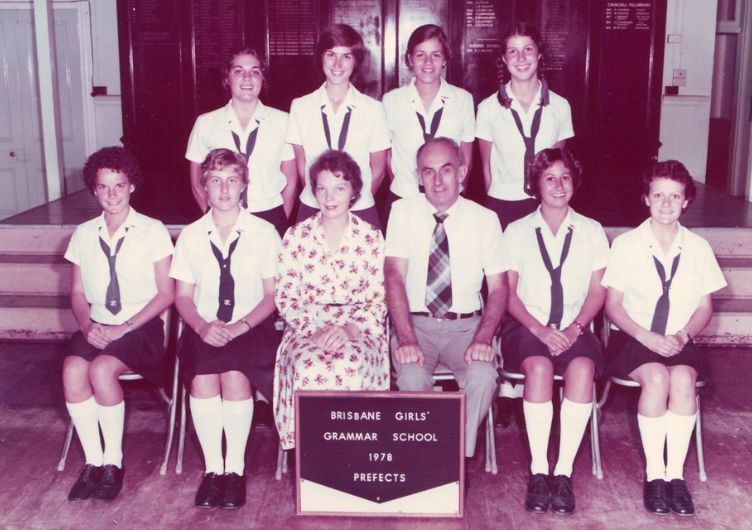
1978 Prefects with Mrs J Hancock and Mr A Faragher. Back row: Caroline Somerville, Susan Chalk, Anna Blocksidge, Sandy Wilson. Seated: Jane Baxter, Gale Tyson, Mrs Hancock, Mr Faragher, Susan Gordon, Janette Knudsen.
Other interesting questions arise when studying this Honour Board. One such question is observing that once there was a student named as Head Girl in two successive years. What is the story behind this occurrence? Margaret Bryan was named Head Girl in both 1946 and 1947. Sadly, Margaret is no longer with us; however, her brother, Bob, cast some light on the reason. ‘I’m not sure it has ever happened before or again (Head Girl for two successive years). You can blame our Pop, bless him! Margaret was very young, and Pop just thought she was too young to go to University—no other reason that I know of. It obviously put “Bloss” (Miss Lilley) in a tough spot, but she was a tough lady’ (text message from Bob Bryan 7.3.23).
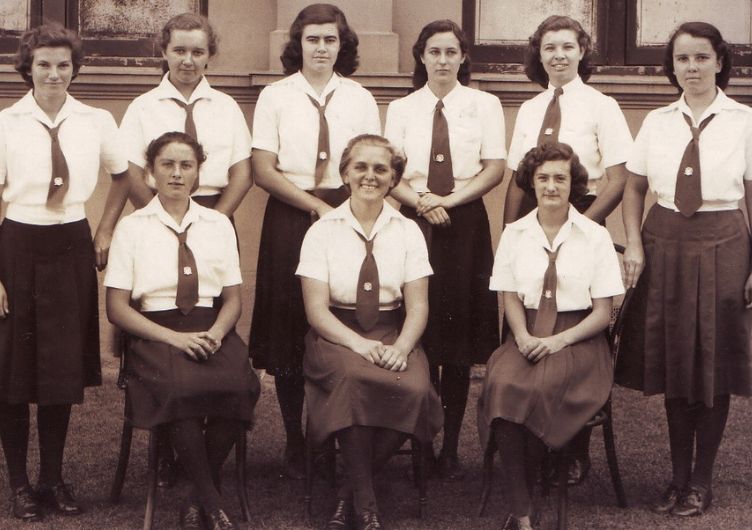
1946 Prefects Back row: Lois Venamore, Joan Herbert, Mary Rae Edye, Jill Lidgard, Norma Karoll, Heather Broadbent. Front row: Margaret Marks, Margaret Bryan (Head Girl), Ann McKee.
Margaret not only was Head Girl for two years, but she also: won the Senior Tennis singles and doubles; was awarded the Munro Cup; received prizes for English and History, ‘Special prizes’, and the VIA Form Prize; and represented the School in the A Tennis team and captained Tennis in 1947. A ‘True Blue’ Grammar girl! Margaret Bryan went on to The University of Queensland, graduated with an Arts Degree, taught briefly at St Hilda’s, Southport, and then in the English Faculty at the university before having a family and moving to Sydney.
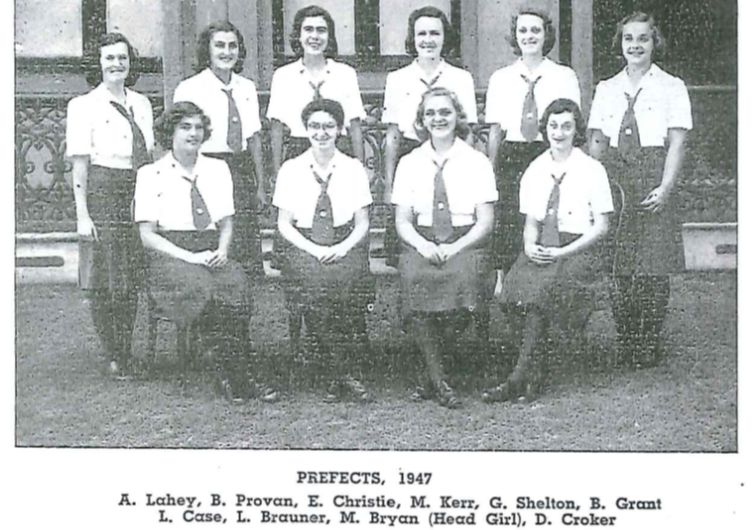
1947 Prefects
From one girl with a two-year appointment to three girls with a one-year appointment! In 1979, the Honour Board lists Anna Joughin, Katrina Heer, and Jennifer O’Donnell as Head Girls. This is the only time the School has had three Head Girls.
On seeing the board, Anna Booys (nee Joughin) said, ‘I remember really noticing the board … in 2019 at our 40th reunion. Katrina and Jenny were both there … I think the fact that we were there together made it memorable for me. It was a real delight to be back in the presence of those two lovely women …’.
Katrina Walker (Heer, 1979) remembers all three girls called to the Principal, Mrs Judith Hancock’s, office where she told them how they balanced each other’s skills. Jennifer was also School Sports Captain and Head Boarder. Anna ‘felt lucky to have them as part of the Head Girls team’ and remembers that Katrina and Jennifer ‘were good at seeing opportunities for “doing something good”…’. Serving the School was uppermost in all three girls’ minds.
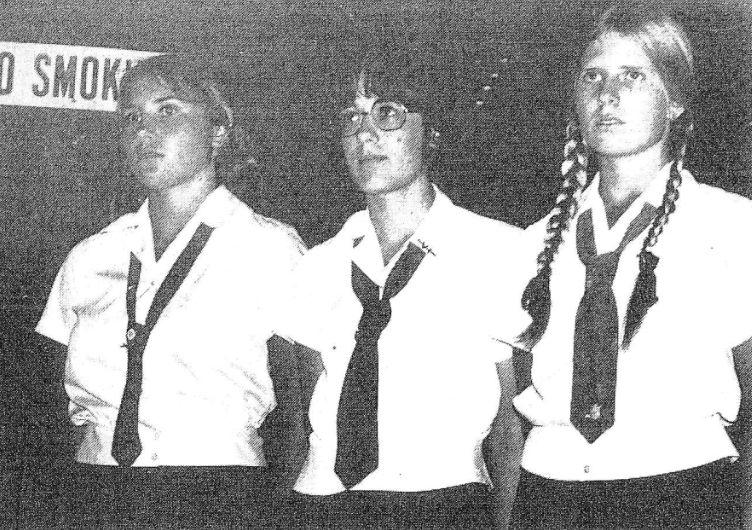
1979 Head Girls: Jennifer O'Donnell, Anna Joughin and Katrina Heer.
It appears that Mrs Hancock was a good judge of character and abilities as these Head Girls received between them at the 1979 Speech Day, the coveted Ida Woolcock Challenge Cup, the Principal’s Prize for Service, the DE Catt Memorial Prize for Service in the Boarding House, prize for Geography, prize for Modern History, were involved in a range of service groups, and represented the School in multiple music groups, debating, and sporting teams including cross country, softball, ballgames, netball, athletics, and judo.
Just as with the oversight of our early Head Girls not being recorded, mistakes can be easily made when creating these prestigious and public boards. One example is often spotted by the Year 7s when being introduced to the School history in the Annie Mackay Room by the Humanities Faculty. Girls frequently ask, ‘Where did Dorothy Rutter go?’ This observation is made owing to the evidence of this name being removed.
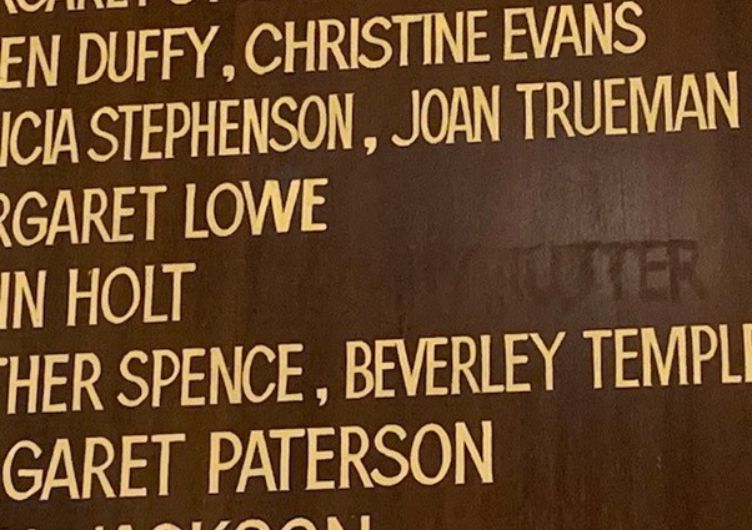
2023—if one looks closely, the ghost of a name can be seen.
In 1960, the sole Head Girl was Robyn Holt. At the 40th reunion of the 1960 Grammar women, this ever-vigilant cohort noticed that there were two Head Girls’ names. It appears that Dorothy Rutter was a prefect and a winner of a university scholarship. It seems that a mistake was made and the sign writer placed her name on both the Head Girls Board and The University of Queensland Scholarships section on the Mackinlay Honour Board.
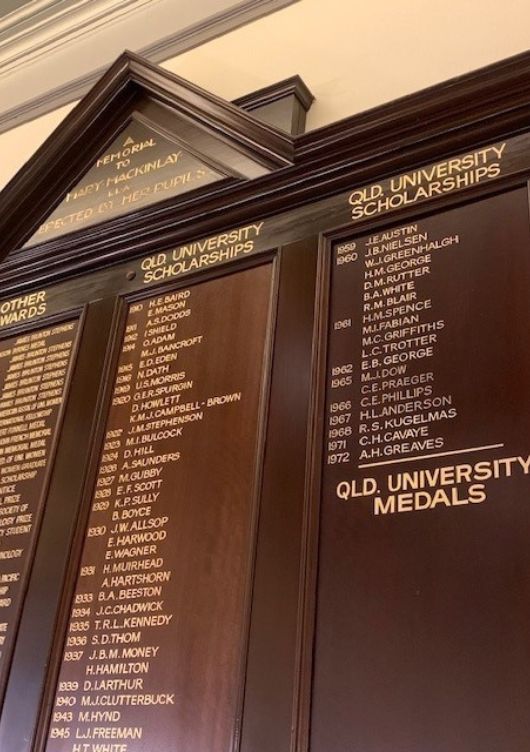
The Mackinlay Honour Board displaying the Dorothy Rutter scholarship in 1960.
Every one of these Grammar girls did not accept the position of Head Girl for power or notoriety. They accepted the position with the intent of leading well and serving their community. This is beautifully illustrated by the responses from the Head Girls when asked for their feelings on seeing their name on the board for the first time.
Alison Jack (McAdam, 1980) states, ‘I must admit I felt a bit overwhelmed and humbled seeing my name amongst all the previous four years’ Head Girls whom I had looked up to, respected, and admired.’ Karalyn Shaw (Orr, 1993) similarly recalls, ‘I remember feeling, in equal parts, really grateful for the opportunity, excited, and a little anxious about the adventures and challenges that lay ahead that year for me and Camilla and our grade, and just really honoured and humbled to be listed amongst the names of the women who preceded us—a few of whom I knew personally or had read or heard about and had looked up to …’.
A lovely story told by Elizabeth Marks, Head Girl 1950, alludes to the variation of the appointment of Head Girls, peoples’ perceptions of this position, and the women who accepted this role.
‘One afternoon early in the first term of 1950, two good looking intellectual girls from our sixth form were summonsed separately to see Headmistress, Miss Lilley. They returned to class, and I was called. I knocked on her door. She said, “Come in,” which I did, and stood in front of her desk. She said, “What would you say if I asked you to be Head Girl?” I replied: “It would be an honour.”
‘”Right,” she said, “that’s settled. There will be much to discuss and attend to. I’ll announce it tomorrow.” Dismissal was a brief wave of her hand. I returned to class.
Months later, and now firmly ensconced as Head Girl, a quick dash to the toilet block announced notoriety. The wall of the cubicle I’d chosen had portrayed in black writing: “Liz Marks thinks she’s great”. Not exactly complimentary. At lunch time I hurried back with cleaning equipment. Someone had added in bigger letters: “She is.”
Quandary—should I wait for further comment or miss basketball practice trying to erase the poorly executed lettering? Ted, the groundsman, was invaluable.’
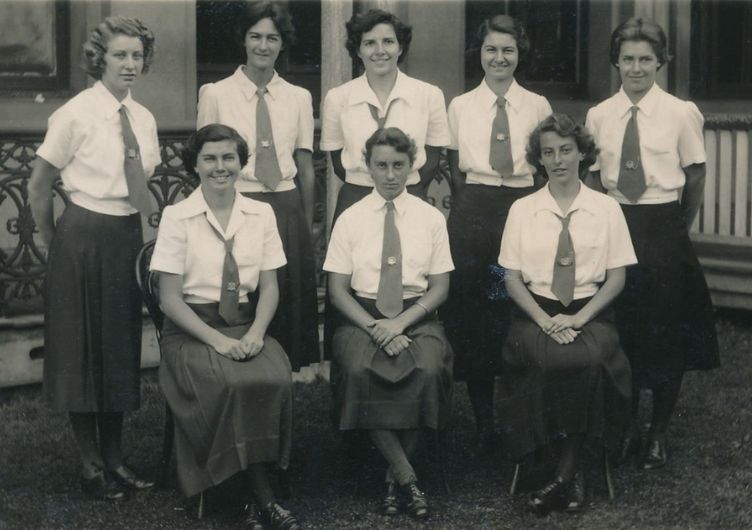
Back row: Georgina Kathryn Quin, Rosemary Maclean, Lyndal Edmiston, Margaret Roberts, Dorothy Barbara Payne. Front row: Barbara Cochran, Elizabeth Marks (Head Girl), Claire Savage.
The Head Girls Honour Board has been placed in the Annie Mackay Room for a very good reason. It is central to the School; it is a well-frequented space by all age groups and staff; it is where our guests are ushered into and introduced to our community; historically, the whole school once met here for daily assembly; it was the home for thousands of boarders; and it speaks to all of achievement, honour, aspiration, and service.
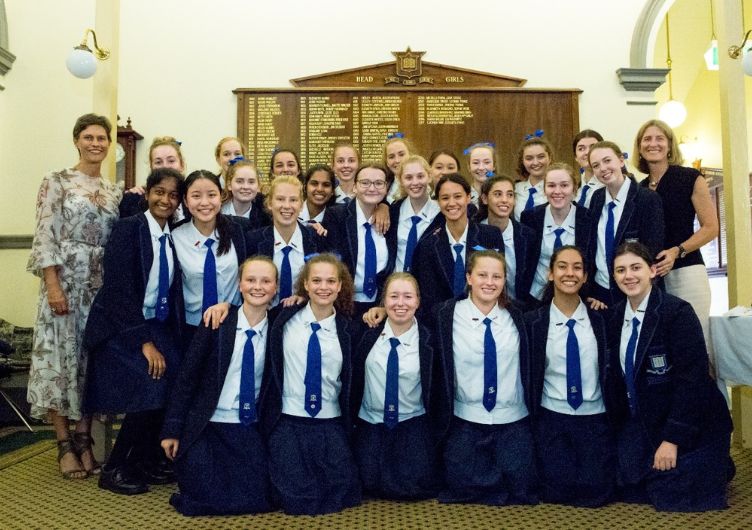
2017 Student Council with Grainia Schmelzer (OGA Executive) and Trustee, Ann Harrap (Head Girl, 1984).
Elizabeth Jameson, Head Girl 1982, Board of Trustees member, and previous Chair of the Board, captures the impact this role can have when she states, ‘… to this day when I look at that list and see the girls in the years before me who I looked up to so much as Head Girls, and the truly amazing young women I saw in the role in more recent years from my new vantage point as Chair, well, it is hard not to feel incredibly honoured. That amazing leadership opportunity set the course for so much else in my life, including my later preparedness just to “go for it”, including … putting my hat in the ring for a place on the board and then later as its Chair.’
Pauline Harvey-Short
Manager, School History and Culture
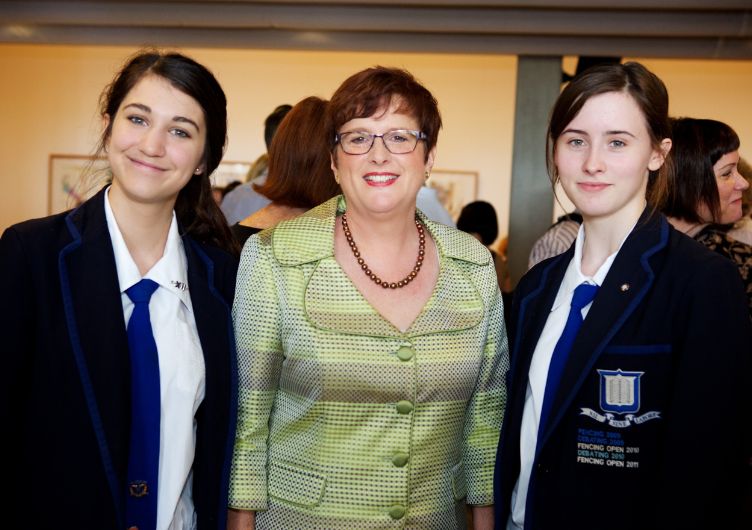
2013 Head Girls, Sophie Weir and Elizabeth Redmond with Trustees Chair, Elizabeth Jameson.
References
BGGS 1897, 1977, 1978,1979 Annual Reports.
BGGS Archives, Recollections 9 March 1973 of Mrs Olive Thatcher nee Adam and Mrs Emily Roe nee Haymen
BGGS Archives, Recollections 3 May 1973 of Miss Marjorie Elliott
BGGS 1915-25 School Magazine
BGGS Board Minutes 1989-1990
Email from Anna Booys nee Joughin 11.4.23
Email from Katrina Walker nee Heer 12.4.23
Email from Karalyn Shaw nee Orr 17.4.23
Email from Elizabeth Jameson 17.4.23
Email from Esther Arumugam nee Jenkins 17.4.23
Email from Alison Jack nee McAdam 18.4.23
Email from Judith Hancock 18.4.23
Email from Ann Harrap 18.4.23
Email from Diana Lohrisch 18.4.23
Email from Sheena Boughen 19.4.23


